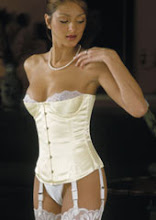
Corseted women were often depicted in the pottery and carvings of early civilisations such as Crete, Assyria and Egypt. There may have been a link between corset wearing and the worship of the sun and of snakes, which were credited with magical powers; a coiled serpent symbolised the sun. One Cretan urn, over 5,000 years old, shows a priestess of the snake cult wearing a bronze corset with the classic hour glass shape, fastened at the waist by two serpents, whose heads and tails meet.The Romans used tight lacing as a form of domination over slaves to show their subjugation and low status, in contrast to the loose robes of their masters and mistresses. Early Christian fanatics would, as a penance, bind their waists with rope until it cut into their flesh, and in contrast the dissolute women of Alexandria and Constantinople mocked this zeal by wearing elaborate tight belts, made of precious metals and decorated with jewels.
From the 15th century, the hour glass figure was fashionable again with both men and women, who wore bodices stiffened with wood, whalebone and even wrought iron corsets. Henry III of France had a tiny waist which was the envy of the court. His mother, Catherine de' Medici, imposed a 13 inch limit on her ladies and their maids. Even allowing for bodies 400 years ago being smaller than modern ones, these "cages" must have been intensely painful. The trend continued into the 18th century and comfort was not the only thing sacrificed to fashion; a letter of Horace Walpole's in 1777 describes the other restrictions of ladies' corsets with steel bones: "If a hero attempts to storm such strong lines, and comes to a close engagement, he must lie as ill at ease as St. Lawrence on his gridiron.".
Men too suffered; 19th century beaux frequently laced their corsets tightly - in 1834 that great dandy "Prinny", the Prince Regent, was warned "to give up his stays as the wearing of them any longer ... would kill him".
The Victorian age saw the last great heyday of the corset, when the tinier the female waist, the more attractive a figure was considered. A girl's ambition was to be married before 21, with a waist measurement less than the years of her age.
In pursuit of this ideal, corsets were laced so tightly that numbness in the lower body and legs and even fainting were frequent occurrences, reinforcing the popular image of the female as a fragile, helpless creature. In reality, women had to be true stoics, enduring severe discomfort while remaining outwardly serene; it was considered disgraceful to show any distress, especially in front of the maid pulling on the laces, or in company. Even when sleeping, they did not escape, as a night-time model would often be worn, in order to maintain the waist reduction achieved during the day.
For the Victorians, with their repressed sensuality bubbling under the surface, there was more to all this masochism than the mere pursuit of fashion; in 1870, a reader of "The Englishwoman's Domestic Magazine" naively wrote that "tight lacing produces delicious sensations, half pleasure, half pain". In an age of heightened prudery, the corset was in fact a socially acceptable method of self titillation!
It was also an acceptable method of torture; many of the trappings of this obsession with waist reduction would not be out of place in a modern dungeon; the unfortunate young girl being "figure trained" hung onto an overhead bar while mother and maid hauled on the laces; an extra long and tight corset was a favourite method of disciplining recalcitrant girls, sometimes with metal screws to tighten more than was possible with laces; a stocking needle might be placed in a schoolgirl's busk to improve posture - any drooping of the head would result in a sharp prick to the chin!
The fad for tiny waists gradually disappeared from fashion around the First World War, and was replaced by a more natural figure and less restrictive underwear, mirroring women's growing emancipation in society.








